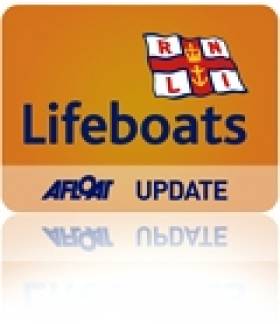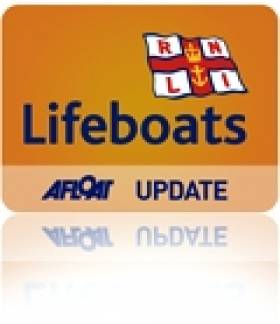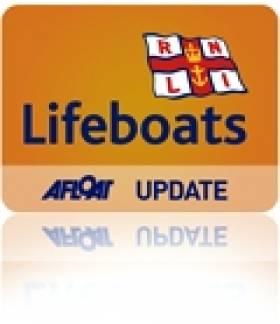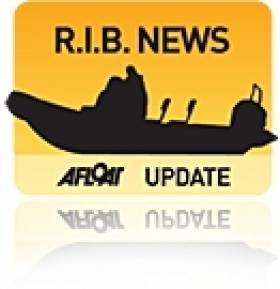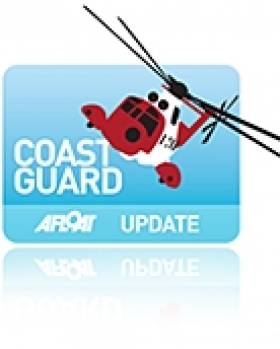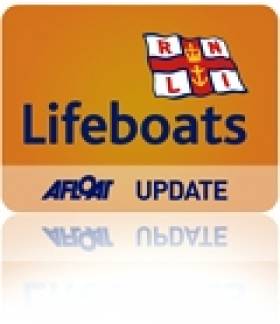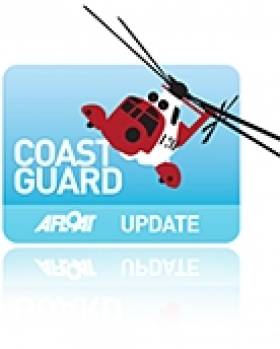Displaying items by tag: Lifeboats
President Mary McAleese names the first Tamar class RNLI lifeboat in Ireland at Kilmore Quay
The RNLI volunteers with Kilmore Quay lifeboat station are the first to receive the new €3 million lifeboat, which is the most modern and technically advanced lifeboat in the RNLI fleet. The new lifeboat, which is named Killarney (ON 1298) was funded by a legacy from Mrs Mary Weeks of Surrey in England who passed away in 2006.
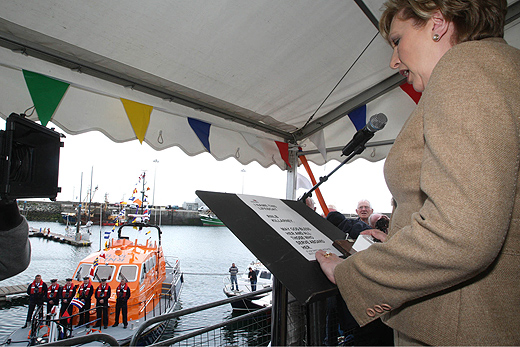
Mrs Weeks met her husband while on a cruise off the west coast of Scotland on a boat named Killarney. Mrs Weeks had a strong RNLI connection through her maiden name Distin. She was a relation of the Coxswain of Salcombe lifeboat Samuel Distin and of lifeboat crewmember Albert Distin; both men lost their lives in the Salcombe lifeboat disaster of 1916.
Mrs. Weeks' niece Mrs Betty Hull, her great niece Mrs Anne Piggford and great nephew David Hull were special guests at the ceremony. Speaking during the ceremony the President of Ireland, Mary McAleese addressed the crowds with the lifeboat alongside, " Everything that is good about human nature is gathered on this day. All the good qualities, all the things that people are capable of doing out of goodness, generosity, love, kindness, care concern; all gather around the naming of this boat this day. It comes to us by way of gift, it has been blessed and the gift itself is a blessing.

A blessing not just to those that take the boat into their ownership this day but to the people someday who will need this blessing and need its gift. For almost two hundred years now the RNLI has stories to tell of saving literally ten of thousands of lives. Tens of thousands of people who could call on the lifeboat, call on the volunteer crews and in particular without knowing it call on the generosity of people who would never get on the boat. Who like Mary Weeks would never see the boat, never live to see it but would give it as an act of generosity to future people, complete strangers who she would never know."
The new Tamar class lifeboat is 16.3 metres in length with a maximum speed of 25 knots compared to the 14.3 metres of the current Tyne class lifeboat stationed at Kilmore Quay, which has a maximum speed of 18 knots. The lifeboat is self-righting and is fitted with an integrated electronics systems and information management system, which allows the lifeboat crew to monitor, operate and control many of the boats systems from shock mitigating seats.
The Tamar also carries a Y boat (an inflatable daughter boat) which is housed under the aft deck and deployed from a hinged door in the transom. The lifeboat has room for 44 survivors.
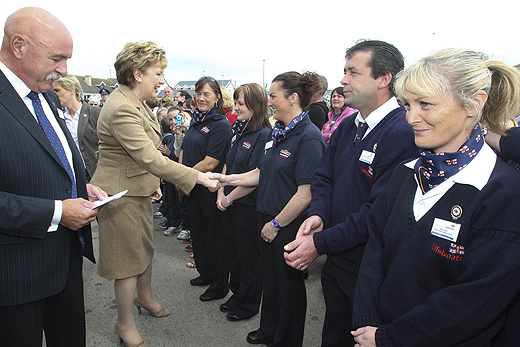
Sink or Swim RNLI Sea Safety Evening a Fantastic Success
With a vision to end preventable loss of life at sea the Royal National Lifeboat Institution are proactively engaged in delivering clear straight forward safety advice to everyone going afloat.
RNLI Volunteer Peter Bullick along with his team of presenters delivered a thought provoking sea safety message which enthralled as well as entertained all those who attended. The main message of the evening highlighted six safety tips for anyone going afloat. The RNLI use the phrase IT'S WET to help you remember this important advice.
I – Inform, Tell others where you're going.
T – Training, Knowledge of your activity is essential.
S – SOS Device, Carry a meanings of calling for help.
W – Wear a lifejacket, A life statement, not a fashion one – wear it.
E – Engine and fuel check, Have you sufficient fuel and spares?
T – Tide and weather, Check the conditions before heading out.
The RNLI's free sea safety check is offered to all boat owners.
Two Vessels Collide off Isle of Man
At 0600 this morning the 17-metre fishing boat 'Lynn Marie' called Liverpool Coastguard to report a collision between their vessel and the 155 metre coaster 'MV Philip'. Although there was minimal damage to the coaster, the fishing vessel suffered extensive damage to her port side bow and began taking on water. Liverpool Coastguard requested the launch of the Port St Mary RNLI Lifeboat, and other vessels in the area including the HM Customs Cutter 'Sentinel'.
Crew from the Port St Mary Lifeboat boarded the fishing vessel with their pump, along with a pump from the Sentinel, to try and stop it from taking on water. The Port Erin RNLI Lifeboat was also launched to provide an extra pump. The Port St Mary Lifeboat then towed the fishing vessel stern first (due to the damage) into the harbour at Port St Mary.
Liverpool Coastguard Watch Manager Su Daintith said:
"The fishing vessel Lynn Marie arrived alongside at Port St Mary at 0941 with the intention to tow her into the inner harbour at high water. The coaster MV Philip proceeded on to its original destination of Greenock.
We have informed the Marine Accident Investigation Branch of this incident."
Two Boys Rescued From Holyhead Harbour
Holyhead RNLI's lifeboat was dispatched on Tuesday morning to rescue two boys from a rocky outcrop just outside Holyhead harbour.
The boys, aged 13 and 14, had ventured out to Piebio Island, which is accessible at low tide, but quickly became stranded when the water rose.
After receiving a 999 call from the boys, Holyhead Coastguard tasked Holyhead RNLI with their recovery. The boys were soon retrieved and returned to school by the coastguard rescue team.
Holyhead Coastguard watch manager Barry Priddis urged anyone going to the coast over the Easter school holidays to make sure they keep aware of the tide times.
"We want everyone to enjoy their holidays at the coast and to go home safe," he said.
Details of 8th Annual Rib Run Unveiled
Details of the eighth annual Rib Run from Cork to Wales were announced on Thursday.
The event will see 15 rigid inflatable boats (ribs) set off from Kinsale on 5 May following a 400-nautical-mile route to Aberystwyth.
The Irish Examiner reports that in previous years the Rib Run has raised more than €260,000 for RNLI lifeboats and the south coast trawler tragedy appeal.
According to event chairman David O'Leary, all crews taking part pay their own expenses which ensures that all money raised goes to charity.
For more details visit www.kinsaleribrun.org
Coast Guard Appeals Over Chinese Lanterns
The Coast Guard has appealed the public to notify them before lighting and releasing Chinese lanterns.
The lanterns have been a regular sight in the night sky since the beginning of the year, but can resemble emergency flares when they drift out to sea.
Marine rescue services maintain that they have been responsible for an increasing number of false callouts. At least six RNLI boats around the country have been launched as a result of mistakenly identified Chinese lanterns.
Lives could be lost if rescue services are distracted by such false alarms, urged Mike Swan, operations manager of RNLI Galway Lifeboat.
RTÉ News has more on the story HERE.
Castletownbere Lifeboat Transfers Injured Man from Bere Island to Bantry in Blizzard
Lifeboat crew with Castletownbere RNLI launched this afternoon (Tuesday 21 December 2010) at 3.30pm to transfer a man from Bere Island to Bantry in West Cork after he was injured in a fall. The lifeboat crew had to step in after heavy snows made the roads in Bantry impassable and stopped the ferry running.
The man in his thirties was transferred onto the lifeboat at Bere Island and brought to Bantry to be met by a waiting fire brigade. The casualty was then brought to hospital for treatment. Conditions at sea were fair but with a very heavy snow falling.
Commenting on the callout Deputy Second Coxswain Paul Stevens said, "This was a callout in very challenging conditions. Due to the heavy snowfall in West Cork the roads in some places are impassable and travel is very difficult. We were delighted to be able to help out and ensure that the man was transferred quickly to receive emergency treatment. Our lifeboats are there to save lives wherever we can."
Related Safety posts
RNLI Lifeboats in Ireland
Safety News
Rescue News from RNLI Lifeboats in Ireland
Coast Guard News from Ireland
Water Safety News from Ireland
Marine Casualty Investigation Board News
Marine Warnings
Single Handed Yachtsman Caught in Gale Calls for Assistance
The yacht owner had been seeking permission to come into the harbour seeking a safe haven as the weather conditions had begun to deteriorate, and the Coastguard were alerted by the harbour authorities. The harbour authorities expressed concern at the time about the condition of the vessel, a 22 foot, single masted, single person crewed vessel with a blue hull. The weather forecast was suggesting westerly winds of 21 to 29 knots at St Bees Head.
However by 5.40 am the yacht still endeavouring to keep out of the weather and he reported to the harbour authorities that he had taken a lot of water into his vessel. He was reassured by the authority that the Coastguard had been informed and the Whitehaven Coastguard Rescue Team were turned out. The Workington RNLI all weather lifeboat were also requested to launch.
By now the wind was gusting 42 knots and had turned to the north west which meant it was blowing straight into the harbour and causing the skipper major problems as the vessel was being thrown against the pier in the outer harbour. He was trapped in his cabin.
The Cumbria Coastguard Sector Manager was also alerted, and an ambulance called.
By 6.30 this morning the RNLI all weather boat had arrived and deploying their small 'Y' boat they sent two crew members across to the 'Tern' to get the skipper out from the badly flooded yacht. In the confined activities, one Coastguard Team Member was hit by the flailing mast and was taken to hospital. The skipper of the yacht was also taken to hospital suffering from hypothermia.
Paul Campbell, Watch Manager at Liverpool Coastguard said
"This was quite an awkward job in very difficult and deteriorating weather conditions. Fortunately the skipper is now safely in hospital and our own Coastguard Rescue Officer was given a check by the A&E department and discharged."
Night in Igloo Raises funds for the RNLI
Brothers Rory (37) and Eoin (36) O'Connor spent last night (Thursday 2 December 2010) in an igloo on Duncannon beach in county Wexford to raise funds for RNLI lifeboats. The pair went into the home-made igloo at 8pm last night and emerged this morning at 8am.
The igloo was built on Duncannon beach by local men Patrick Byrne and David Walsh following plummeting temperature and heavy snowfall in the southeast. On hearing of the structure, Rory and Eoin approached the men to ask if they could spend a night in the igloo to raise funds for RNLI lifeboats. With their agreement they made plans to spend the evening in the ice and brought with them special clothing and sleeping bags to brave the arctic temperatures.
Rory is a volunteer lifeboat helm on Fethard-on-Sea D class inshore lifeboat in county Wexford and when the temperatures dropped on the south-east coast he and his brother Eoin decided to do something to raise funds for the RNLI and to remind people that lifeboat crew go out in all types of weather.
Speaking from the igloo at the end of their night Fethard lifeboat helm Rory said "We are honestly delighted with the response from the public to our sleepover. People were dropping by the igloo all night to say hello and drop some money in the bucket. We even had a local pub send down some hot whiskeys to keep us warm. It was actually quite comfortable and we even managed to get a good night's sleep."
The brothers emerged this morning in good spirits and were looking forward to a cooked Irish breakfast on the beach.
Rory and Eoin have set up a donations page HERE. The brothers have so far raised over €1,500 for the lifeboats.

A night in the cold has produced 1500 Euros so far!
Fire on Board Stena Ferry
Two lifeboats proceeded to the Stena Pioneer this afternoon after crew on the ferry issued a mayday call reporting a fire in their engine room whilst they were on passage to Fleetwood on the Irish Sea. A helicopter was also placed on standby.
Liverpool Coastguard received the mayday at 3.36 pm and made contact with crew on board the vessel, who reported that they still had full power and steering but that there was a fire in the engine room that they were fighting with their on board fire fighting equipment.
Liverpool Coastguard sent lifeboats from Fleetwood and Barrow to the scene. The fire was reported as out at 4.30 pm and the ferry is now docked at Fleetwood.
Liverpool Coastguard Watch Manager Paul Parkes said:
"A fire on a ferry 12 miles out with 46 people on board could potentially turn into a very serious incident, and so we acted quickly to send rescue resources to its aid. Luckily, the fire was dealt with using on board equipment and so the lifeboats escorted the ferry into Fleetwood where it was met by Lancashire Fire and Rescue service and an MCA surveyor."


























